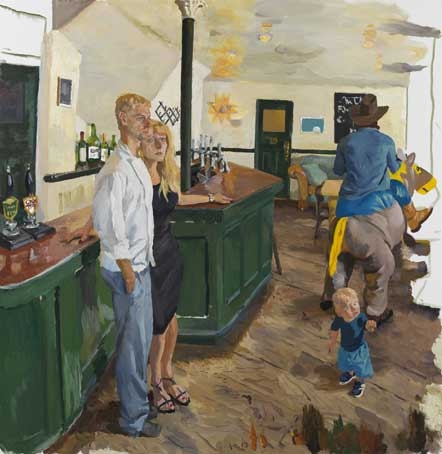On the face of it, Liu Xiaodong’s latest exhibition at the Lisson Gallery in London reinforces usual descriptions of the artist’s work as ‘realist’. At the exhibition’s core is a series of large-scale paintings depicting the interiors of two public houses and a restaurant that have been rendered with a distinctly under-idealising eye for detail.
In one painting a large dog slumps over a bar counter while its presumed owners stand in attendance, dressed in stained chef ’s whites and scruffy summer working casuals. In another, an oriental style interior, uncannily empty of people, is represented; its kitschy petrolite surfaces and serpentine decorations contrasting with the sentinel presence of two starkly black, symmetrically counterposed electric fans.
Liu’s work is open to differing socio-cultural perspectives
In yet another, a vampirically grey-skinned and sclerotic-eyed couple, again dressed in working clothes, preside bathetically over a pub interior in which a young child at play on a roughly boarded wooden floor seeks to return our gaze.
For those familiar with the urban interiors of London this is the instantly recognisable territory of the quick (or not so quick) after-work drink and the drunkenly impulsive late night curry or kebab – a world of intensely cosmopolitan babble and conversational telegraphings of almost certainly exaggerated urban professional lifestyles. Impressively, Liu has the visual semiotics of this intensely mixed-up gentrified ‘spit and sawdust’ world down more or less pat.
Liu’s capacity to render the ripped backside of London life in such apparently knowing detail was aided not only by the artist’s now well-established method of painting in situ, but also by his interacting actively with the individuals and communities he depicts. This signature approach no doubt enables Liu to gain far greater insights into the significance of the social milieus into which he enters than any amount of anonymous sketching or photograph taking.
It is also one well in tune with the persistence of realism as a dominant aesthetic within the mainstream (officially supported) artworld of Liu’s home territory – the People’s Republic of China – where he is a professor at Beijing’s prestigious Central Academy of Fine Arts. That aesthetic was self-consciously adopted during the early twentieth century as a culturally distinct framework for the development of a socially inclined and progressive modern art.
Yet Liu’s actively engaged approach also allows his work to be aligned with the current international fashion for an art of social intervention and relationality. That sense of relationality is further supplemented by conspicuously unfinished passages throughout Liu’s painting , passages that are left as metaphorical invitations to the viewer to ‘complete’ the work.
As is the artist’s sometimes visually disjunctive use of multiple panels as part of the making of a single image, both of which suggest a contemporary ‘conceptual’ re-motivation of conventional realist techniques (a reading that Liu himself actively resists).
In short Liu’s work is open to differing socio-cultural perspectives: including one that enables him to work successfully within the prevailing socio-political conditions of the PRC and another conferring critical credibility within western(ised) contexts.
Like other contemporary ‘realist’ artists from China, a searching understanding of the multiple significances of Liu’s work lies beyond a single gallery visit. Liu’s current and highly engaging exhibition at the Lisson Gallery is, though, a very good place to start.
This article was first published in the November 2013 issue of ArtReview Asia
